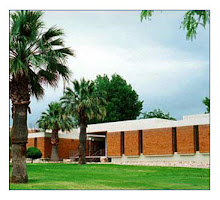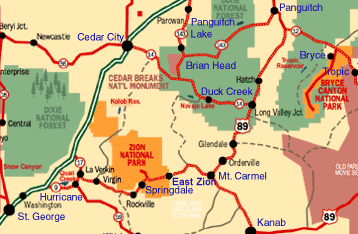

 Star Nursery, today
Star Nursery, todayOne of St. George’s neighboring towns is Washington City. Washington, named after our first president of the U.S., was established by the pioneers around the late 1850’s, before the now bustling town of St. George came into existence, which the pioneers also established. Washington was settled mainly at that time to grow cotton. Because of the war soon to break out between the North and South states, it was evident that obtaining cotton from the southern states was going to halt.
The climate and weather conditions were perfect in Washington City and trial cotton crops were planted, proving that cotton could grow and mature there and cloth made from it. By 1870 the Cotton Factory was fully completed with three floors, enabling the cloth to be produced there rather than having the lint baled and sent away to others to produce cloth. This offered a ready market for the cotton grown.
The factory never was a real money maker but it helped keep the pioneers in the area and provided them with work and an income, which they could not get anywhere else. It also supplied them with the cloth they needed to make their clothes.
Once the railroad came through and the Civil War ended, the pioneers were able to obtain goods from the east, and the need to raise cotton decreased. The Factory was closed in 1910 and basically stood empty for around 75 years.
The Civilian Conservation Corps used the factory grounds for their campground in the 1930’s and in 1985 the old cotton factory property was saved from demolition and was renovated and used for a community social hall and the Washington Cotton Factory was then listed on the national register as a Utah Historic Site.
In 1998, the old factory building and grounds was resold and the lower floor of the building and most of the grounds were converted into a nursery and landscaping business called Star Nursery, which prospers today.
Click on the following link to see photos and read more:
http://www.millpictures.com/mills/details.cfm?millid=886
The climate and weather conditions were perfect in Washington City and trial cotton crops were planted, proving that cotton could grow and mature there and cloth made from it. By 1870 the Cotton Factory was fully completed with three floors, enabling the cloth to be produced there rather than having the lint baled and sent away to others to produce cloth. This offered a ready market for the cotton grown.
The factory never was a real money maker but it helped keep the pioneers in the area and provided them with work and an income, which they could not get anywhere else. It also supplied them with the cloth they needed to make their clothes.
Once the railroad came through and the Civil War ended, the pioneers were able to obtain goods from the east, and the need to raise cotton decreased. The Factory was closed in 1910 and basically stood empty for around 75 years.
The Civilian Conservation Corps used the factory grounds for their campground in the 1930’s and in 1985 the old cotton factory property was saved from demolition and was renovated and used for a community social hall and the Washington Cotton Factory was then listed on the national register as a Utah Historic Site.
In 1998, the old factory building and grounds was resold and the lower floor of the building and most of the grounds were converted into a nursery and landscaping business called Star Nursery, which prospers today.
Click on the following link to see photos and read more:
http://www.millpictures.com/mills/details.cfm?millid=886






















